
Umberto Eco was an Italian medievalist, philosopher, semiotician, novelist, cultural critic, and political and social commentator. In English, he is best known for his popular 1980 novel The Name of the Rose, a historical mystery combining semiotics in fiction with biblical analysis, medieval studies and literary theory, as well as Foucault's Pendulum, his 1988 novel which touches on similar themes.

Albert I was King of the Belgians from 23 December 1909 until his death in 1934.

Jacques Lucien Jean Delors was a French politician who served as the eighth president of the European Commission from 1985 to 1995. Delors played a key role in the creation of the single market, the euro and the modern European Union.

The Grand Alliance, sometimes erroneously referred to as its precursor the League of Augsburg, was formed on 20 December 1689. Signed by William III on behalf of the Dutch Republic and England, and Emperor Leopold I for the Habsburg Monarchy, its primary purpose was to oppose the expansionist policies of Louis XIV of France.
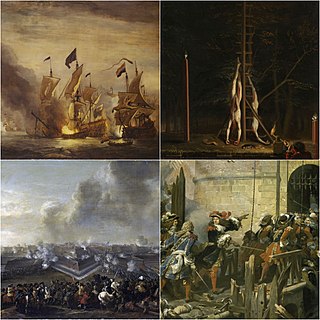
The Franco-Dutch War, also known as the Dutch War, was fought between France and the Dutch Republic, supported by its allies the Holy Roman Empire, Spain, Brandenburg-Prussia and Denmark-Norway. In its early stages, France was allied with Münster and Cologne, as well as England. The 1672 to 1674 Third Anglo-Dutch War and 1675 to 1679 Scanian War are considered related conflicts.
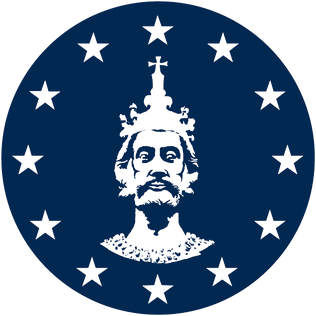
The Charlemagne Prize is a prize awarded for work done in the service of European unification. It has been awarded since 1950 by the German city of Aachen. It commemorates Charlemagne, ruler of the Frankish Empire and founder of what became the Holy Roman Empire, who was the first to unify Western Europe following the Fall of the Western Roman Empire. Traditionally the award is given to the recipient on Ascension Day in a ceremony in the Aachen Town Hall. In April 2008, the organisers of the Charlemagne Prize and the European Parliament jointly created a new European Charlemagne Youth Prize, which recognises contributions by young people towards the process of European integration. Patrons of the foundation are King Philippe of Belgium, King Felipe VI of Spain, and Henri, the Grand Duke of Luxembourg.

The War of the Reunions (1683–84) was a conflict between France, Spain and the Holy Roman Empire, with limited involvement by Genoa. It can be seen as a continuation of the War of Devolution (1667–1668) and the Franco-Dutch War (1672–1678), which were driven by Louis XIV's determination to establish defensible boundaries along France's northern and eastern borders.

Le Cateau-Cambrésis is a commune in the Nord department in northern France. The term Cambrésis indicates that it lies in the county of that name which fell to the Prince-Bishop of Cambrai. Le Cateau station has rail connections to Paris, Maubeuge and Saint-Quentin.

Spanish Netherlands was the Habsburg Netherlands ruled by the Spanish branch of the Habsburgs from 1556 to 1714. They were a collection of States of the Holy Roman Empire in the Low Countries held in personal union by the Spanish Crown. This region comprised most of the modern states of Belgium and Luxembourg, as well as parts of northern France, the southern Netherlands, and western Germany with the capital being Brussels. The Army of Flanders was given the task of defending the territory.
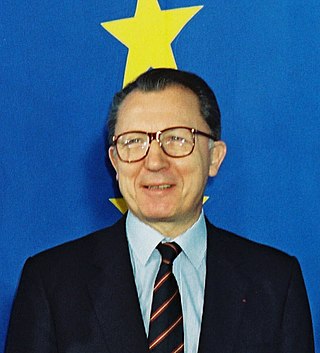
The Delors Commission was the administration of Jacques Delors, the eighth President of the European Commission. Delors presided over the European Commission for three terms. The first term lasted from 1985 to 1988, the second until 1992 and the final one until 1994, making Delors the longest serving president, and his Commission is also seen as the most successful at advancing European integration. It was the only Commission to serve three times, and Delors served five two-year terms. The third Commission was the first Commission of the European Union, the Maastricht Treaty having come into force in 1993.

The Treaties of Peace of Nijmegen were a series of treaties signed in the Dutch city of Nijmegen between August 1678 and October 1679. The treaties ended various interconnected wars among France, the Dutch Republic, Spain, Brandenburg, Sweden, Denmark-Norway, the Prince-Bishopric of Münster, and the Holy Roman Empire. The most significant of the treaties was the first, which established peace between France and the Dutch Republic and placed the northern border of France very near its modern position.

The Battle of Saint-Denis was the last major action of the Franco-Dutch War (1672-78). It took place on 14 August 1678, four days after Louis XIV of France had agreed the Treaty of Nijmegen with the Dutch Republic, but before he finalised terms with Spain. The battle was initiated by the Dutch and Spanish forces to prevent the French capturing the Spanish-held town of Mons, then on the border between France and the Spanish Netherlands. The result was disputed, as both sides claimed victory.
Events from the year 1635 in art.

The founding fathers of the European Union are men who are considered to be major contributors to European unity and the development of what is now the European Union. The number and list of the founding fathers of the EU varies depending on the source. In a publication from 2013 the European Union listed 11 men. All but one were from the Inner Six of the European Union.

The history of the European Union between 1993 and 2004 was the period between its creation and the 2004 enlargement. The European Union was created at the dawn of the post–Cold War era and saw a series of successive treaties laying the ground for the euro, foreign policy and future enlargement. Three new member states joined the previous twelve in this period and the European Economic Area extended the reach of the EU's markets to three more.

Prince Jaime Bernardo of Bourbon-Parma, Count of Bardi is the second son and third child of Princess Irene of the Netherlands and Carlos Hugo, Duke of Parma. He is a member of the House of Bourbon-Parma as well an extended member of the Dutch royal family. From 2014 to 2018 he was the Dutch ambassador to the Holy See. Until 2021 he was the Senior Advisor Private Sector Partnerships at UNHCR, the United Nations Refugee Agency. Currently he is the Climate Envoy of the Netherlands.
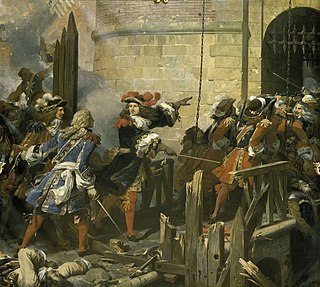
The siege of Valenciennes took place from 28 February to 17 March 1677, during the Franco-Dutch War, when Valenciennes, then in the Spanish Netherlands, was attacked by a French army under the duc de Luxembourg.

The Peace of Lund, signed on 16 September (O.S.) / 26 September 1679, was the final peace treaty between Denmark–Norway and the Swedish Empire in the Scanian War.
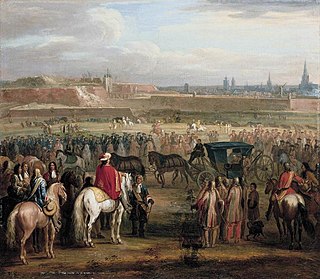
The siege of Cambrai took place from 20 March to 19 April 1677 during the 1672–1678 Franco-Dutch War; then part of the Spanish Netherlands, it was invested by a French army under the duc de Luxembourg. Siege operations were supervised by the military engineer Vauban; Louis XIV was nominally in command but played little part in operations.
The Battle of Ortenbach, also known as the Battle of Gengenbach, took place on 23 July 1678 during the closing stages of the 1672-1678 Franco-Dutch War, in the modern German state of Baden-Württemberg. It featured a French army commanded by François de Créquy and an Imperial force under Charles V, Duke of Lorraine.




















